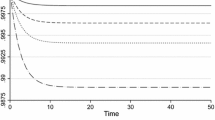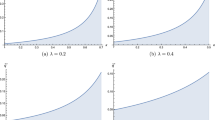Abstract
This paper analyzes the development of the ratio of corporate taxes to wage taxes using a simple political economy model with workers and capitalists that own internationally mobile and immobile firms. Among other results, our model predicts that countries reduce their corporate tax rate, relative to the wage tax, when preferences for public goods increase, or when the share of capital employed in multinational firms is rising. We further show how an increase in the wage share changes both the relative size of tax bases and the political influence of different income groups. The predicted relationships are tested using panel data for 23 OECD countries for the period 1980 through 2004. The results of the empirical analysis support our main hypotheses.
Similar content being viewed by others
References
Apolte, T. (2001). How tame will Leviathan become in institutional competition—competition among governments in the provision of public goods. Public Choice, 107, 359–381.
Baltagi, B. H., & Wu, P. X. (1999). Unequally spaced panel data regressions with AR(1) disturbances. Econometric Theory, 15, 814–823.
Becker, G. (1983). A theory of competition among pressure groups for political influence. The Quarterly Journal of Economics, 98(3), 371–400.
Becker, J., & Fuest, C. (2007). Internationalization and business tax revenue—evidence from Germany. In European tax policy forum research paper. London.
Bretschger, L., & Hettich, F. (2002). Globalisation capital mobility and tax competition: theory and evidence for OECD countries. European Journal of Political Economy, 18, 695–716.
Bucovetsky, S. (1991). Asymmetric tax competition. Journal of Urban Economics, 30, 167–181.
Davis, S., & Henrekson, M. (1999). Explaining national differences in the size and industry distribution of employment. Small Business Economics, 12, 59–83.
De Mooij, R., & Nicodème, G. (2008). Corporate tax policy and incorporation in the EU. International Tax and Public Finance, 15, 478–498.
Devereux, M. P. (2006). The impact of taxation on the location of capital, firms and profit: a survey of empirical evidence. In European tax policy forum research paper. London.
Devereux, M. P., & Griffith, R. (2003). Evaluating tax policy for location decisions. International Tax and Public Finance, 10, 107–126.
Devereux, M. P., & Klemm, A. (2004). Measuring taxes on income from capital: evidence from the UK. In P. B. Sørensen (Ed.), Measuring the tax burden on capital and labor (pp. 73–98). Cambridge: MIT Press.
Devereux, M. P., Griffith, R., & Klemm, A. (2002). Corporate income tax reforms and international tax competition. Economic Policy, 35, 451–495.
Dreher, A. (2006). The influence of globalization on taxes and social policy: an empirical analysis for OECD countries. European Journal of Political Economy, 22, 179–201.
Dreher, A., Sturm, J.-E., & Ursprung, H. W. (2008). The impact of globalization on the composition of government expenditures. Evidence from panel data. Public Choice, 134, 263–292.
European Commission (1997). Towards tax co-ordination in the European Union: a package to tackle harmful tax competition. Document COM (97) 495. Brussels.
European Commission (2001). Towards an internal market without tax obstacles. A strategy for providing companies with a consolidated corporate tax base for their EU-wide activities. Document COM (2001) 582. Brussels.
Eurostat (2005). Structures of the taxation system in the European Union. Luxembourg.
Fuest, C., & Huber, B. (2001). Tax competition and tax coordination in a median voter model. Public Choice, 107, 97–11.
Garretsen, H., & Peters, J. (2007). Capital mobility agglomeration and corporate tax rates: Is the race to the bottom for real? CESifo Economic Studies, 53, 263–293.
Ghosh, A., & Wolf, H. (1997). Geographical and sectoral shocks in the US business cycle (NBER Working Paper, 6180).
Haufler, A., Klemm, A., & Schjelderup, G. (2006). Globalisation and the mix of wage and profit taxes (CESifo Working Paper, 1678).
Hettich, W., & Winer, S. (2004). The political economy of taxation. Positive and normative analysis when collective choice matters. In The encyclopedia of public choice (Vol. 1, pp. 173–191). Dordrecht: Kluwer Academic.
Hibbs, D. A. (1977). Political parties and macroeconomic policy. American Political Science Review, 71, 1467–1487.
Hines, J. R. (1999). Lessons from behavioral responses to international taxation. National Tax Journal, 52, 304–322.
Hotte, L., & Winer, S. (2001). Political influence. economic interests and endogenous tax structure in a computable equilibrium framework: with application to the United States, 1973 and 1983. Public Choice, 109, 69–99.
Jimeno, J. F. (1992). The relative importance of aggregate and sector-specific shocks at explaining aggregate and sectoral fluctuations. Economics Letters, 39, 381–385.
Kenny, L. W., & Winer, S. L. (2006). Tax systems in the world: an empirical investigation into the importance of tax bases administration costs, scale and political regime. International Tax and Public Finance, 3, 181–215.
Kind, H. J., Midelfart, K. H., & Schjelderup, G. (2005). Corporate tax systems, multinational enterprises, and economic integration. Journal of International Economics, 65, 507–521.
Krogstrup, S. (2004). Are corporate tax burdens racing to the bottom in the European Union? (EPRU Working Paper 2004–04). University of Copenhagen.
Markusen, J. (2002). Multinational firms and the theory of international trade. Cambridge: MIT Press.
OECD (2006). Taxing wages. www.new.sourceoecd.org.
OECD (2008). OECD factbook. www.sourceoecd.org/factbook.
Persson, T., & Tabellini, G. (1992). The politics of 1992: fiscal policy and European integration. Review of Economic Studies, 59, 689–701.
Quinn, D. (1997). The correlates of change in international financial regulation. American Political Science Review, 91, 531–551.
Rodrik, D. (1997). Has globalisation gone too far? Institute for International Economics, Washington, DC
Rodrik, D. (1998). Why do more open economies have bigger governments? Journal of Political Economy, 106, 997–1032.
Romer, D. (2006). Advanced macroeconomics (3rd edn.). New York: McGraw Hill.
Schwarz, P. (2007). Does capital mobility reduce the corporate-labor tax ratio? Public Choice, 130, 363–380.
Slemrod, J. (2004). Are corporate tax rates or countries, converging? Journal of Public Economics, 88, 1169–1186.
Swank, D., & Steinmo, S. (2002). The new political economy of taxation in advanced capitalist democracies. American Journal of Political Science, 46, 642–655.
Wilson, J. D. (1991). Tax competition with interregional differences in factor endowments. Regional Science and Urban Economics, 21, 423–451.
Wilson, J. D. (1999). Theories of tax competition. National Tax Journal, 52, 269–304.
Winner, H. (2005). Has tax competition emerged in OECD countries? Evidence from panel data. International Tax and Public Finance, 12, 667–687.
Author information
Authors and Affiliations
Corresponding author
Rights and permissions
About this article
Cite this article
Haufler, A., Klemm, A. & Schjelderup, G. Economic integration and the relationship between profit and wage taxes. Public Choice 138, 423–446 (2009). https://doi.org/10.1007/s11127-008-9368-9
Received:
Accepted:
Published:
Issue Date:
DOI: https://doi.org/10.1007/s11127-008-9368-9




